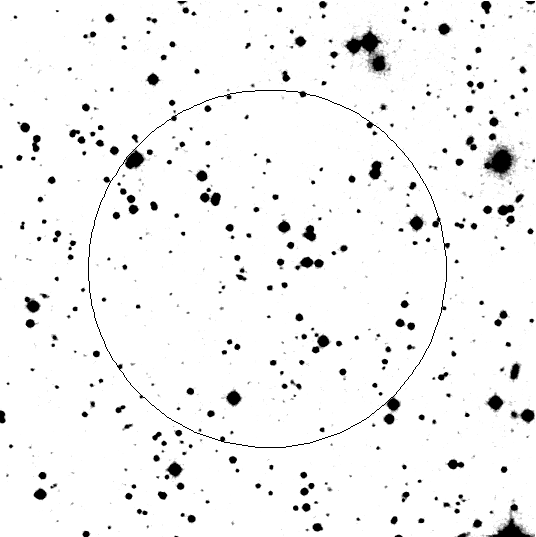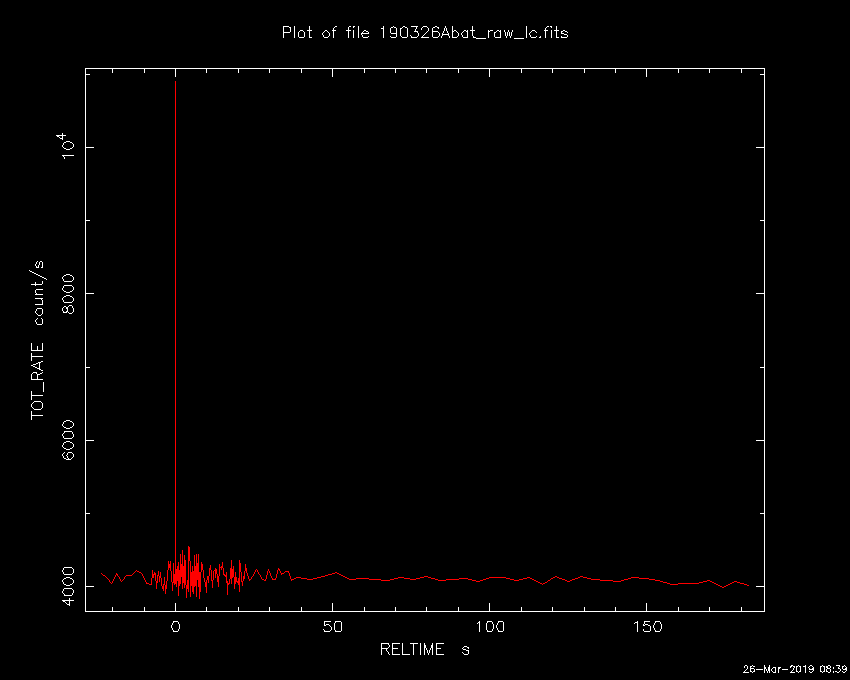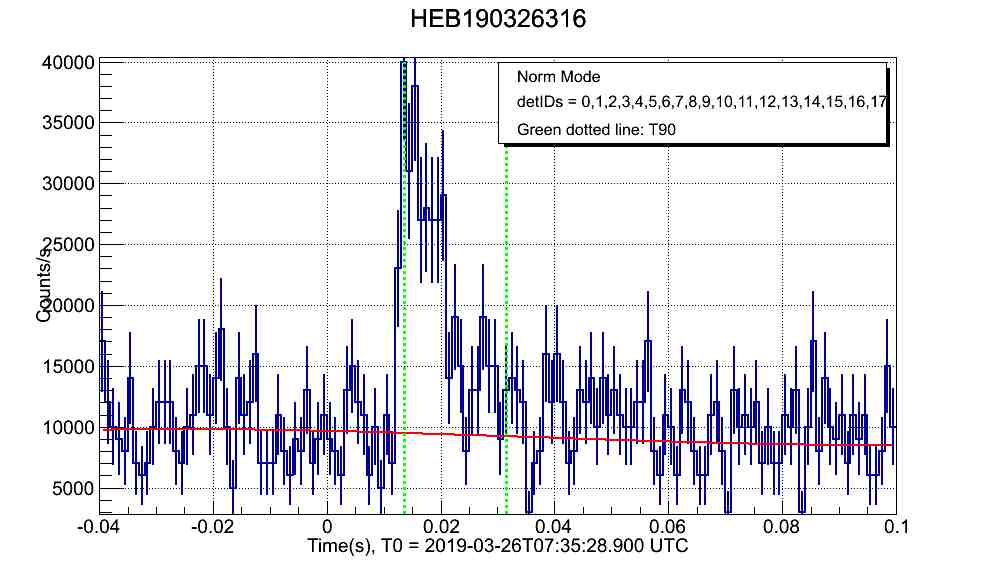- GCN/BACODINE POSITION NOTICE
TITLE: GCN/SWIFT NOTICE
NOTICE_DATE: Tue 26 Mar 19 07:35:42 UT
NOTICE_TYPE: Swift-BAT GRB Position
TRIGGER_NUM: 895006, Seg_Num: 0
GRB_RA: 341.652d {+22h 46m 37s} (J2000),
341.871d {+22h 47m 29s} (current),
341.086d {+22h 44m 21s} (1950)
GRB_DEC: +39.903d {+39d 54' 09"} (J2000),
+40.004d {+40d 00' 15"} (current),
+39.639d {+39d 38' 20"} (1950)
GRB_ERROR: 3.00 [arcmin radius, statistical only]
GRB_INTEN: 480 [cnts] Image_Peak=86 [image_cnts]
TRIGGER_DUR: 0.032 [sec]
TRIGGER_INDEX: 10318 E_range: 25-100 keV
BKG_INTEN: 16126 [cnts]
BKG_TIME: 27313.36 SOD {07:35:13.36} UT
BKG_DUR: 8 [sec]
GRB_DATE: 18568 TJD; 85 DOY; 19/03/26
GRB_TIME: 27328.72 SOD {07:35:28.72} UT
GRB_PHI: -14.61 [deg]
GRB_THETA: 39.57 [deg]
SOLN_STATUS: 0x3
RATE_SIGNIF: 44.83 [sigma]
IMAGE_SIGNIF: 10.57 [sigma]
MERIT_PARAMS: +1 +0 +0 -5 +2 +0 -100 +0 -72 +0
SUN_POSTN: 4.92d {+00h 19m 41s} +2.13d {+02d 07' 46"}
SUN_DIST: 43.26 [deg] Sun_angle= 1.5 [hr] (West of Sun)
MOON_POSTN: 253.07d {+16h 52m 17s} -19.21d {-19d 12' 20"}
MOON_DIST: 101.32 [deg]
MOON_ILLUM: 68 [%]
GAL_COORDS: 98.38,-16.94 [deg] galactic lon,lat of the burst (or transient)
ECL_COORDS: 2.64, 43.20 [deg] ecliptic lon,lat of the burst (or transient)
COMMENTS: SWIFT-BAT GRB Coordinates.
COMMENTS: This is a rate trigger.
COMMENTS: A point_source was found.
COMMENTS: This does not match any source in the on-board catalog.
COMMENTS: This does not match any source in the ground catalog.
COMMENTS: This is a GRB.
COMMENTS: This trigger occurred at longitude,latitude = 73.94,20.30 [deg].
- red DSS finding chart
ps-file

- GCN NOTICE
TITLE: GCN/SWIFT NOTICE
NOTICE_DATE: Tue 26 Mar 19 07:39:07 UT
NOTICE_TYPE: Swift-BAT GRB Lightcurve
TRIGGER_NUM: 895006, Seg_Num: 0
GRB_RA: 341.652d {+22h 46m 37s} (J2000),
341.871d {+22h 47m 29s} (current),
341.086d {+22h 44m 21s} (1950)
GRB_DEC: +39.903d {+39d 54' 09"} (J2000),
+40.004d {+40d 00' 15"} (current),
+39.639d {+39d 38' 20"} (1950)
GRB_DATE: 18568 TJD; 85 DOY; 19/03/26
GRB_TIME: 27328.91 SOD {07:35:28.91} UT
TRIGGER_INDEX: 10318
GRB_PHI: -14.61 [deg]
GRB_THETA: 39.57 [deg]
DELTA_TIME: 46.00 [sec]
TRIGGER_DUR: 0.032 [sec]
SOLN_STATUS: 0x3
RATE_SIGNIF: 44.83 [sigma]
IMAGE_SIGNIF: 10.57 [sigma]
LC_URL: sw00895006000msb.lc
SUN_POSTN: 4.92d {+00h 19m 42s} +2.13d {+02d 07' 49"}
SUN_DIST: 43.26 [deg] Sun_angle= 1.5 [hr] (West of Sun)
MOON_POSTN: 253.10d {+16h 52m 24s} -19.21d {-19d 12' 40"}
MOON_DIST: 101.30 [deg]
MOON_ILLUM: 68 [%]
GAL_COORDS: 98.38,-16.94 [deg] galactic lon,lat of the burst (or transient)
ECL_COORDS: 2.64, 43.20 [deg] ecliptic lon,lat of the burst (or transient)
COMMENTS: SWIFT-BAT GRB Lightcurve.
COMMENTS:
COMMENTS: The next comments were copied from the BAT_POS Notice:
COMMENTS: This is a rate trigger.
COMMENTS: A point_source was found.
COMMENTS: This does not match any source in the on-board catalog.
COMMENTS: This does not match any source in the ground catalog.
COMMENTS: This is a GRB.
COMMENTS: This trigger occurred at longitude,latitude = 73.94,20.30 [deg].

- GCN Circular #24009
M. H. Siegel (PSU), A. Y. Lien (GSFC/UMBC), K. L. Page (U Leicester)
and B. Sbarufatti (PSU) report on behalf of the Neil Gehrels Swift
Observatory Team:
At 07:35:28 UT, the Swift Burst Alert Telescope (BAT) triggered and
located GRB 190326A (trigger=895006). Due to an observing constraint,
Swift did not slew to the burst. The BAT on-board calculated location is
RA, Dec 341.652, +39.903 which is
RA(J2000) = 22h 46m 37s
Dec(J2000) = +39d 54' 09"
with an uncertainty of 3 arcmin (radius, 90% containment, including
systematic uncertainty). The BAT light curve showed a single-peaked
structure with a duration of about 0.1 sec. The peak count rate
was ~7000 counts/sec (15-350 keV), at ~0 sec after the trigger.
Due to a Sun observing constraint, Swift cannot slew to the BAT
position until 12:47 UT on 2019 April 13. There will thus be no XRT or
UVOT data for this trigger before this time.
Burst Advocate for this burst is M. H. Siegel (siegel AT swift.psu.edu).
Please contact the BA by email if you require additional information
regarding Swift followup of this burst. In extremely urgent cases, after
trying the Burst Advocate, you can contact the Swift PI by phone (see
Swift TOO web site for information: http://www.swift.psu.edu/)
- GCN Circular #24016
M. Niwano, K. L. Murata, R. Itoh, Y. Tachibana,
K. Morita, K. Iida, K. Shiraishi, R. Adachi, M. Oeda, Y. Yatsu,
and N. Kawai (Tokyo Tech) report on behalf of the MITSuME collaboration
We searched for the optical counterpart of
GRB 190326A (M. H. Siegel et al., GCN #24009)
with optical three color (g', Rc, and Ic) cameras attached to the
MITSuME 50 cm
reflector in the Okayama Astrophysical Observatory, Japan.
The observation started at 19:01:19 UT which corresponds to 41151
sec since the trigger.
We did not find any new point source within the Swift BAT error circle
(M. H. Siegel et al., GCN #24009) in all three bands.
The obtained 5 sigma upper limits of the optical counterpart are
summarize below:
T0+[sec] MID-UT T-EXP[sec] g' Rc Ic
-------------------------------------------------------------------------------------------------------
41151 19:33:27 600 >16.8 >16.8 >16.2
-------------------------------------------------------------------------------------------------------
T0+ : Elapsed time after the burst
T-EXP: Total Exposure time
We used UCAC-4 catalog for flux calibration.
- GCN Circular #24018
Q. Luo, C. K. Li, X. B. Li, G. Li, J. Y. Liao, S. L. Xiong,
C. Z. Liu, X. F. Li, Z. W. Li, Z. Chang, X. F. Lu,
A. M. Zhang, Y. F. Zhang, C. L. Zou (IHEP), Y. J. Jin,
Z. Zhang (THU), T. P. Li (IHEP/THU), F. J. Lu, L. M. Song,
M. Wu, Y. P. Xu, S. N. Zhang (IHEP),
report on behalf of the Insight-HXMT team:
At 2019-03-26T07:35:28.900 (T0), the Insight-HXMT/HE detected
GRB 190326A(trigger ID: HEB190326316) in a routine search of the data,
which was also triggered by Swift/BAT(M. H. Siegel et al. ,GCN 24009)
and MITSuME (M. Niwano et al. ,GCN 24016).
The Insight-HXMT/HE light curve mainly consists of two
pulses with a duration (T90) of 0.018 s measured from T0+0.01s.
The 1-ms peak rate, measured from T0+0.011 s, is 30499 cnts/sec.
The total counts from this burst is 234 counts.
URL_LC: http://www.hxmt.org/images/GRB/HEB190326316_lc.jpg
All measurements above are made with the CsI detectors operating in the
regular mode with the energy range of about 80-800 keV (record energy).
Only gamma-rays with energy greater than about 200 keV can penetrate
the spacecraft and leave signals in the CsI detectors installed inside
of the telescope.
Insight-HXMT is the first Chinese space X-ray telescope, which was
fundedjointly by the China National Space Administration (CNSA) and
the Chinese Academy of Sciences (CAS).
More information about it could be found at:
http://www.hxmt.org.

- GCN Circular #24020
C. B. Markwardt (GSFC), S. D. Barthelmy (GSFC),
S. B. Cenko (GSFC), J. R. Cummings (CPI),
H. A. Krimm (NSF/USRA), A. Y. Lien (GSFC/UMBC),
D. M. Palmer (LANL), T. Sakamoto (AGU),
M. Stamatikos (OSU), T. N. Ukwatta (LANL), G. Younes (GWU)
(i.e. the Swift-BAT team):
Using the data set from T-240 to T+963 sec from the recent telemetry
downlink,
we report further analysis of BAT GRB 190326A (trigger #895006)
(Siegel et al., GCN Circ. 24009). The BAT ground-calculated position is
RA, Dec = 341.652, 39.914 deg which is
RA(J2000) = 22h 46m 36.6s
Dec(J2000) = +39d 54' 50.3"
with an uncertainty of 1.6 arcmin, (radius, sys+stat, 90% containment).
The partial coding was 57%.
The mask-weighted light curve shows a FRED-like pulse structure that starts
and peaks at ~T0, and ends at ~T+0.1 s. T90 (15-350 keV) is 0.08 +- 0.03
sec
(estimated error including systematics).
The time-averaged spectrum from T+0.00 to T+0.10 sec is best fit by
a power law with an exponential cutoff. This fit gives a photon index
-0.67 +- 0.92,
and Epeak of 33.9 +- 4.9 keV (chi squared 97.5 for 56 d.o.f.). For this
model the total fluence in the 15-150 keV band is 6.3 +- 0.8 x 10^-8 erg/cm2
and the 1-sec peak flux measured from T-0.45 sec in the 15-150 keV band is
1.55 +- 0.30 ph/cm2/sec. All the quoted errors are at the 90% confidence
level.
The unusually soft spectrum (for a short GRB) and the very short duration
show resemblance with an SGR. Therefore, we also compare the spectral fit
from a blackbody model, which yields a similar reduced chi square
(i.e., chi squared 99.89 for 55 d.o.f.) with kT = 9.39 keV. This kT is
consistent
with small-flare events from SGRs. However, the source location is not
really
close to the galactic plane (b = -16.9 deg), nor does it match with any
known SGRs.
If this is a GRB, this is one of the softest short bursts detected by BAT
(based on a sample with constrained spectral fits from the 3rd BAT GRB
catalog;
Lien & Sakamoto et al. 2016). Another BAT-detected short GRB with similar
softness and duration is GRB140622A, which was classified to be a short GRB
because the XRT light curve is consistent with the normal behavior of a
short burst
(Sakamoto et al. 2014; Burrows et al. 2014). Unfortunately, due to the
observing
constraint, we do not have information from XRT/UVOT, and thus it is
difficult to
determine the burst origin at this point. Further X-ray observations may
clarify the physical origin.
The results of the batgrbproduct analysis are available at
http://gcn.gsfc.nasa.gov/notices_s/895006/BA/
- GCN Circular #24023
Y.-D. Hu, X.-Y.Li, E. Fernandez-Garcia, A. Ayala, A. J. Castro-Tirado
(IAA-CSIC), C. Perez del Pulgar, A. Castellon, I. Carrasco (Univ. de
Malaga), R. P. Hedrosa and I. Hermelo (CAHA) on behalf of a larger
collaboration, report:
Following the detection of the short-soft event GRB 190326A by Swift
(Siegel et al. GCNC 24009), we triggered the 2.2m telescope (+CAFOS) at
the Spanish Calar Alto Observatory (Almeria, Spain). Observations were
conducted at high airmass starting on March 28, 04:22:52 UT (i.e. 1.87
day after the trigger). A series of BVRI imaging (500s per filter) shows
no optical afterglow down to 21 mag (in the calibrated R-band image)
within the Swift/BAT error box (1.6 arcmin, Markwardt et al. GCNC 24020).
We acknowledge excellent support from the CAHA staff.
This message can be quoted.
- GCN Circular #24129
B. Sbarufatti (PSU), P. Kuin (MSSL/UCL) and M. H. Siegel (PSU) report on behalf of the Swift-XRT team:
Swift has performed XRT and UVOT follow-up observations of BAT detected GRB 190326A (Siegel et al. GCN Circ. 24009), after it came out of the Sun observing constraint.
The data were collected between T0+18.91 days and T0+18.98 days, for a total exposure of 1.9 ks in Photon Counting (PC) mode for XRT and with the UVW1 filter for UVOT.
No uncatalogued X-ray sources have been detected. The 3-sigma upper limit at the BAT refined position (Markwardt et al. GCN Circ. 24020) is 1.95E-2 ct s^-1, corresponding to a 0.3-10 keV observed flux of 9.75E-13 erg cm^-2 s^-1 (assuming a typical GRB spectrum).
The UVOT also does not detect any new source at the BAT refined position.
Preliminary 3-sigma upper limits using the UVOT photometric system (Breeveld et al. 2011, AIP Conf. Proc. 1358, 373) for the first finding chart (FC) exposure and subsequent exposures are:
Filter T_start(ks) T_stop(ks) Exp(ks) Mag
uvw1 1633 1640 1.89 >20.47
The magnitudes in the table are not corrected for the Galactic extinction due to the reddening of E(B-V) = 0.10 in the direction of the burst (Schlegel et al. 1998).
The BAT refined analysis pointed out that the unusually soft spectrum hinted at a possible SGR nature for the source.
However, a non detection at T+18.9 days is consistent with the expected behavior of a short GRB, and we conclude that it is more likely that the event was a Gamma Ray Burst.
This circular is an official product of the Swift XRT and UVOT teams.
![]() Previous IAU Circulars
Previous IAU Circulars 

